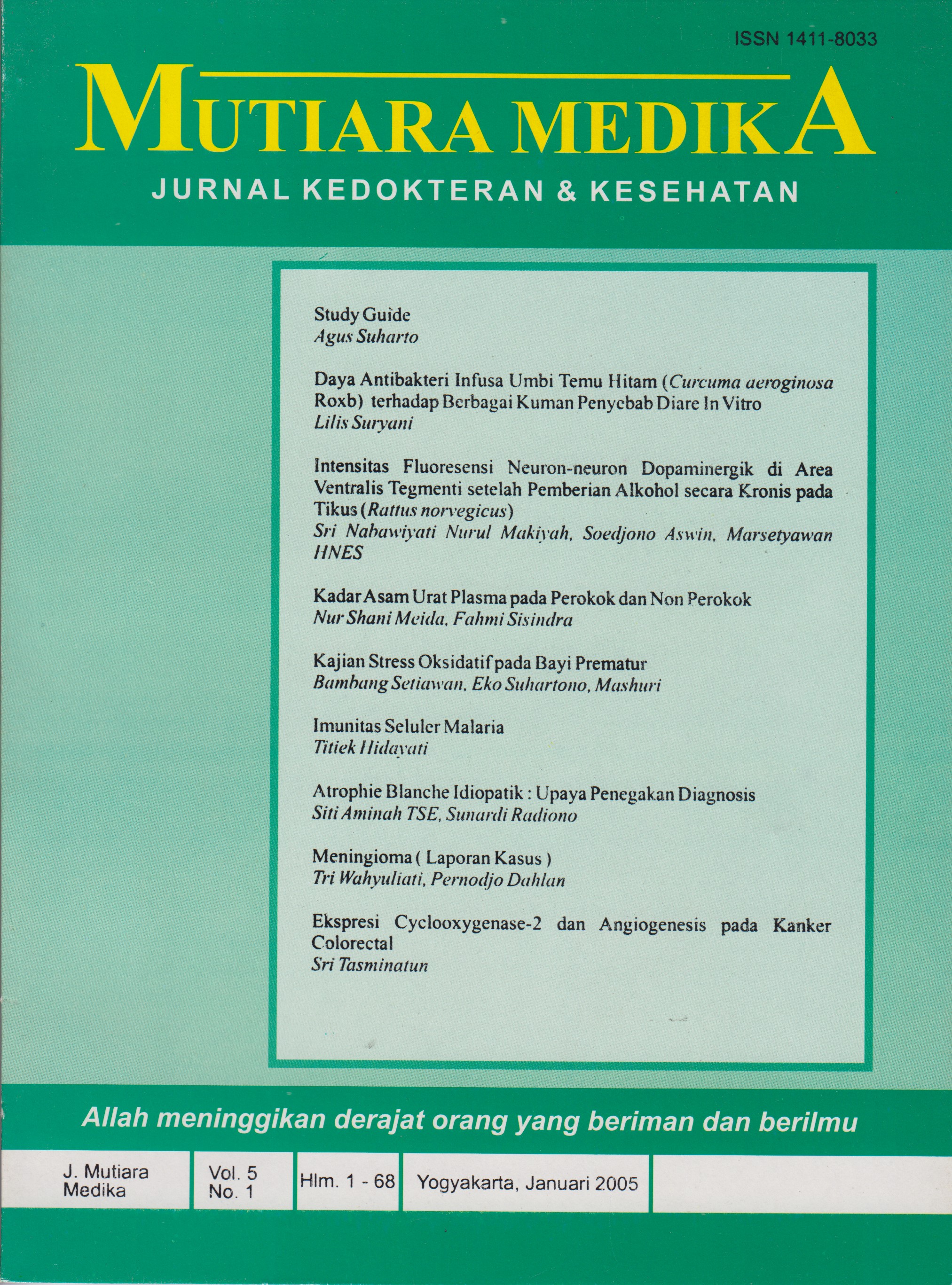Kajian Stress Oksidatif Pada Bayi Prematur
DOI:
https://doi.org/10.18196/mmjkk.v5i1.1861Keywords:
bayi prematur, stress oksidatif, senyawa oksigen reaktif, antioksidan, preterm babies, oxidative stress, reactive oxygen species, antioxidantAbstract
Preterm babies can be considered as a disease with an oxidative stress compo-nent. Beside that, in preterm babies found any disease which have causal link with the action of reactive oxygen species. Damaged which mediated by reactive oxygen species caused bay decreased of endogenous antioxidant defense. In the hospital preterm babies can expose by some source o oxidative stress, such blood transfusion, high concentration oxygen therapy, and parenteral nutrition feeding.Bayi prematur dapat dipertimbangkan sebagai penyakit akibat komponen stress oksidatif. Kerusakan yang ditimbulkan oleh Senyawa Oksigen Reaktif tersebut diperantarai oleh rendahnya sistem antioksidan endogen. Di samping itu, dalam perawatan di rumah sakit, bayi prematur sering terpajan berbagai kondisi yang merupakan sumber stress oksidatif. Kondisi tersebut dapat berupa transfusi darah, terapi oksigen konsentrasi tinggi, dan pemberian makan dengan nutrisi parenteral.
References
Stone WL, 1999. Oxidative stress and antioxidants in premature infants in Antioxidant status, diet, nutrition, and health. Papas AM editor. FloridarCRC Press.
Silvers KM, Gibson AT, Russel JM, Powers HJ, 1998. Antioxidant activity, packed cell transfu¬sions, and outcome in premature infants. Arch Dis Child Fetal Neonatal Ed, 78:214-9.
Hirano K, Morinobu T, Kim H, Hiroi M, Ban R, Ogawa S, et al, 2001. Blood transfusions increases radical promoting non-tranferrin bound iron in preterm infants. Arch Dis Child Fetal Neonatal Ed, 84:188-93.
Bolisetty S, Naidoo D, Lui K, Koh THHG, Watson D, Whitehall J, 2002. Antenatal supplementa¬tion of antioxidant vitamins to reduce the oxidative stress at delivery-apilot study. Early Human Dev, 67:47-53.
Suryohudoyo P, 2000. Kapita selekta ilmu kedokteran molekuler. Jakarta: Penerbit Sagung Seto.
Halliwell B, Whiteman M, 2004. Measuring reactive species and oxidative damage in vivo and in cell culture: how you should do it and what do the results mean? Br J Pharm, 142(2):231-55.
Dani C, Martelli E, Bertini G, Pezzati M, Filippi L, Rossetti M, et al, 2003. Plasma bilirubin and oxidative stress in preterm infants. Arch Dis Child Fetal Neonatal Ed, 88:119-23.
Ramaekers VT, Bosnian B, Jansen GA, Wanders RJA, 1997. Increased plasma malondyaldehide associated with cerebellar structural defects. Arch Dis Child, 77:231-4.
Buonocore G, Perrone S, Longini M, Vezzosi P, Marzocchi B, Paffetti P, et al, 2002. Oxidative stress in preterm neonates at birth and on the seventh day of life. Pediatr Res, 52 (l):46-9.
Giles BL, Hagir S, Lisa BM, Claude AP, Tim DO, Eva NG, 2002. Prenatal hypoxia decreases lung extracellular superoxide dismutase expression and activity. Am J Physiol Lung Cell Mol Physiol, 283:549-54.
Halliwel B, Gutteridge JMC, 1999. Free radical in biology and medicine. 3rd Edition. New York: Oxford University Press.
Winterboum CC, Chan T, Buss IH, Inder TE, Mogridge N, Darlow BA, 2000. Protein carbonyls and lipid peroxidation products as oxidation markers in preterm infant plasma: associations with chronic lung disease and retinopathy and effects of selenium supplementation. Pediatr Res, 48(1 ):84- 90.
Robles R, Palomino N, Robles A, 2001. Oxidative stress in the neonate. Early Human Dev, 65:575- 81.
Baydas G, Karatas F, Gursu MF, Bozkurt HA, Ilhan N, Yasar A, et al, 2002. Antioxidant vitamin levels in term and preterm infants and their relation to maternal vitamin status. Arch Med Res, 33:276-80.
Wardle SP, Hughes A, Chen S, Shaw NJ, 2001. Randomized controlled trial of oral vitamin A in preterm infants to prevent chronic lung disease. Arch Dis Child Fetal Neonatal Ed, 84:9-13.
Yigit S, Yurdakok M, Kilinc K, Oran O, Erdem G, Tekinalp G, 1999. Serum malondialdehyde concentration in babies with hyperbilirubinemia. Arch Dis Child Fetal Neonatal Ed, 80:235-7.
Wardle SP, Drury J, Garr R, Yoxall CW, Weindling AM, 2002. Effect of blood transfusions on lipid peroxidation in preterm infants. Arch Dis Child Fetal Neonatal Ed, 86:46-8.
Ogihara T, Hirano K, Morinobu T, Kim HS, Hiroi M, Ogihara H, et al, 1999. Raised concentration of aldehyde lipid peroxidation products in premature infants with chronic lung disease. Arch Dis Child Fetal Neonatal Ed, 80:21-5.
Ng PC, Lam CWK, Lee CH, To KF, 2001. Hepatic iron storage in very low birthweight infants after multiple blood transfusions. Arch Dis Child Fetal Neonatal Ed, 84:101-5.
Pathak A, Roth P, Pisciteli J, Johnson L, 2003. Effects of vitamin E supplementation during erythropoetin treatment of the anaemia of prematurity. Arch Dis Child Fetal Neonatal Ed, 88:324-8.
Downloads
Issue
Section
License
Copyright
Authors retain copyright and grant Mutiara Medika: Jurnal Kedokteran dan Kesehatan (MMJKK) the right of first publication with the work simultaneously licensed under an Attribution 4.0 International (CC BY 4.0) that allows others to remix, adapt and build upon the work with an acknowledgment of the work's authorship and of the initial publication in Mutiara Medika: Jurnal Kedokteran dan Kesehatan (MMJKK).
Authors are permitted to copy and redistribute the journal's published version of the work (e.g., post it to an institutional repository or publish it in a book), with an acknowledgment of its initial publication in Mutiara Medika: Jurnal Kedokteran dan Kesehatan (MMJKK).
License
Articles published in the Mutiara Medika: Jurnal Kedokteran dan Kesehatan (MMJKK) are licensed under an Attribution 4.0 International (CC BY 4.0) license. You are free to:
- Share — copy and redistribute the material in any medium or format.
- Adapt — remix, transform, and build upon the material for any purpose, even commercially.
This license is acceptable for Free Cultural Works. The licensor cannot revoke these freedoms as long as you follow the license terms. Under the following terms:
Attribution — You must give appropriate credit, provide a link to the license, and indicate if changes were made. You may do so in any reasonable manner, but not in any way that suggests the licensor endorses you or your use.
- No additional restrictions — You may not apply legal terms or technological measures that legally restrict others from doing anything the license permits.



